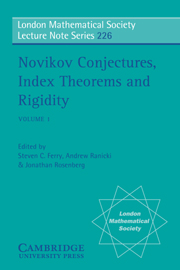Analytic Novikov for topologists
Published online by Cambridge University Press: 07 May 2010
Summary
Abstract. We explain for topologists the “dictionary” for understanding the analytic proofs of the Novikov conjecture, and how they relate to the surgery-theoretic proofs. In particular, we try to explain the following points:
(1) Why do the analytic proofs of the Novikov conjecture require the introduction of C*-algebras?
(2) Why do the analytic proofs of the Novikov conjecture all use K-theory instead of L-theory? Aren't they computing the wrong thing?
(3) How can one show that the index map µ or β studied by operator theorists matches up with the assembly map in surgery theory?
(4) Where does “bounded surgery theory” appear in the analytic proofs? Can one find a correspondence between the sorts of arguments used by analysts and the controlled surgery arguments used by topologists?
The literature on the Novikov conjecture (see [FRR]) consists of several different kinds of papers. Most of these fall into two classes: those based on topological arguments, usually involving surgery theory, and those based on analytic arguments, usually involving index theory. The purpose of this note is to “explain” the second class of papers to those familiar with the first class. I do not intend here to give a detailed sketch of the Kasparov KK-approach to the Novikov conjecture (for which the key details appear in [Kas4], [Fac2], and [KS]), since this has already been done in the convenient expository references [Fac1], [Kas2], [Kas3], [Bla], and [Kas5].
- Type
- Chapter
- Information
- Novikov Conjectures, Index Theorems, and RigidityOberwolfach 1993, pp. 338 - 372Publisher: Cambridge University PressPrint publication year: 1995
- 13
- Cited by



